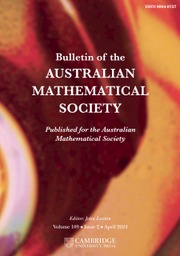We study low-dimensional manifolds through their character variety from two perspectives. Character varieties of low-dimensional manifolds are a rich area of study that reflect geometric and topological information of the underlying manifold. Given a manifold M and an algebraic group G, the G-character variety is loosely the space of conjugacy classes of representations from the fundamental group of M to G, with some conjugacy classes identified so that the resulting space is a variety. We are particularly interested in the situation when M is a hyperbolic surface or 3-manifold and G is
![]() $\operatorname {\mathrm {SL}}_2$
. This is because of the relationship between elements of the character variety and the orientation preserving isometry groups of the hyperbolic plane (
$\operatorname {\mathrm {SL}}_2$
. This is because of the relationship between elements of the character variety and the orientation preserving isometry groups of the hyperbolic plane (
![]() $\operatorname {\mathrm {PSL}}_2(\mathbb {R})$
) and hyperbolic space (
$\operatorname {\mathrm {PSL}}_2(\mathbb {R})$
) and hyperbolic space (
![]() $\operatorname {\mathrm {PSL}}_2(\mathbb {C})$
).
$\operatorname {\mathrm {PSL}}_2(\mathbb {C})$
).
The first perspective uses Teichmüller space and earthquakes. Teichmüller space of a surface is the space of all finite-area complete hyperbolic structures of the surface and can be naturally identified with a component of the associated
![]() $\operatorname {\mathrm {SL}}_2(\mathbb {R})$
-character variety [Reference Goldman5]. There is a natural action on Teichmüller space by earthquakes, which have proved to be powerful in the exploration of these hyperbolic structures [Reference Thurston and Epstein6]. We derive explicit forms of the earthquake deformations on Teichmüller space associated with simple closed curves of the once-punctured torus with both algebraic and geometric interpretations [Reference Garden2]. Examining the limiting behaviour gives insight into earthquakes about measured geodesic laminations, of which simple closed curves are a special case [Reference Garden2].
$\operatorname {\mathrm {SL}}_2(\mathbb {R})$
-character variety [Reference Goldman5]. There is a natural action on Teichmüller space by earthquakes, which have proved to be powerful in the exploration of these hyperbolic structures [Reference Thurston and Epstein6]. We derive explicit forms of the earthquake deformations on Teichmüller space associated with simple closed curves of the once-punctured torus with both algebraic and geometric interpretations [Reference Garden2]. Examining the limiting behaviour gives insight into earthquakes about measured geodesic laminations, of which simple closed curves are a special case [Reference Garden2].
The second perspective uses essential surfaces and the theory of Culler and Shalen. Essential surfaces are orientable, incompressible and boundary-incompressible surfaces in a 3-manifold, and tell us about the inherent geometry and topology of the manifold. Thurston’s hyperbolisation theorem implies these essential surfaces are intimately connected with hyperbolic structures. In the seminal work of Culler and Shalen, essential surfaces in
![]() $3$
-manifolds are associated to ideal points of their
$3$
-manifolds are associated to ideal points of their
![]() ${\mathrm {SL}_2({\mathbb {C}})}$
-character varieties [Reference Culler and Shalen1]. We lay a general foundation for this theory in arbitrary characteristic by using the same approach instead over the
${\mathrm {SL}_2({\mathbb {C}})}$
-character varieties [Reference Culler and Shalen1]. We lay a general foundation for this theory in arbitrary characteristic by using the same approach instead over the
![]() ${\mathrm {SL}_2({\mathbb {F}})}$
-variety of characters for
${\mathrm {SL}_2({\mathbb {F}})}$
-variety of characters for
![]() $\mathbb {F}$
an arbitrary algebraically closed field [Reference Garden and Tillmann4]. We provide several applications of the extended theory, including bounds on dimension of the character variety, the A-polynomial, prime decomposition and JSJ decomposition [Reference Garden, Martin and Tillmann3, Reference Garden and Tillmann4]. We give examples where new essential surfaces are detected in positive characteristic and where an essential surface is never detected in any characteristic.
$\mathbb {F}$
an arbitrary algebraically closed field [Reference Garden and Tillmann4]. We provide several applications of the extended theory, including bounds on dimension of the character variety, the A-polynomial, prime decomposition and JSJ decomposition [Reference Garden, Martin and Tillmann3, Reference Garden and Tillmann4]. We give examples where new essential surfaces are detected in positive characteristic and where an essential surface is never detected in any characteristic.


